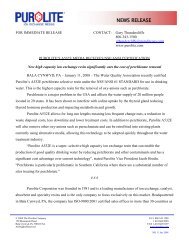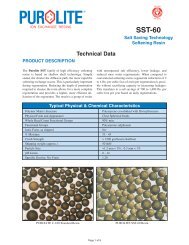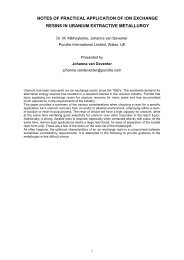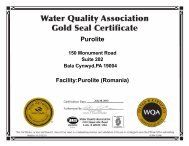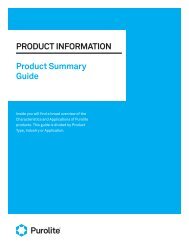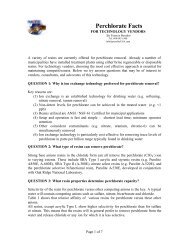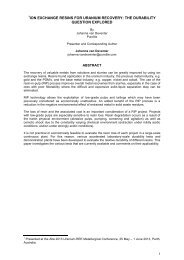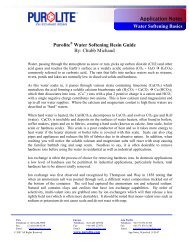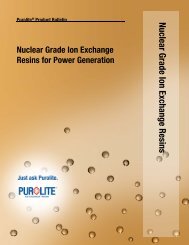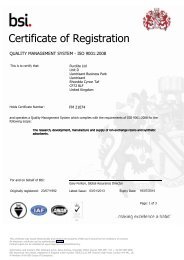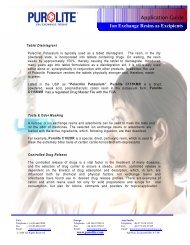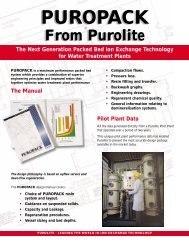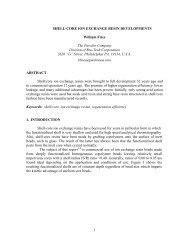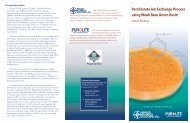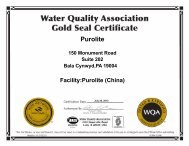Cane Sugar Refining - Purolite
Cane Sugar Refining - Purolite
Cane Sugar Refining - Purolite
You also want an ePaper? Increase the reach of your titles
YUMPU automatically turns print PDFs into web optimized ePapers that Google loves.
<strong>Cane</strong> <strong>Sugar</strong> <strong>Refining</strong> with Ion Exchange Resins<br />
Decolorization<br />
Several techniques can be used for removing color from the sugar juice and they are<br />
subject to continuous developments. The main ones being:<br />
• Activated carbon: Numerous types of activated carbon are available in the<br />
marketplace according to the precursor carbonaceous material (coal, wood,<br />
coconut, etc.) and their size. The most common types used for sugar juice<br />
decolorization being powdered activated carbon (usually termed as PAC) and<br />
granular activated carbon (GAC).<br />
• Polymeric media: This term mostly refers to synthetic ion exchange resins or<br />
adsorbent resins (functionalized or not). There are 2 main polymeric structures<br />
commercially available which differ by their hydrophobicity; the styrenic matrix<br />
which tends to be more hydrophobic and the acrylic structure which is hydrophilic.<br />
In addition to their chemical structure, polymeric adsorbents exhibit some<br />
important porosity.<br />
• Bone char: Pyrolyzed ground animal bones have a high surface area which adsorbs<br />
color and remove some ash.<br />
Evaporation<br />
The raw sugar was melted to 72° Brix to lower the viscosity for filtration and<br />
decolorization, but requires a much higher Brix to achieve a supersaturated sugar<br />
concentration for crystallization in the vacuum pans which are effectively single<br />
effect evaporators. Multiple effect evaporators are used to improve steam economy<br />
while raising the Brix from 68° Brix (after dilution) to approximately 80° Brix.<br />
Crystallization<br />
Evaporative crystallization of the 98° Pol (sucrose purity) decolorized syrup occurs in a<br />
heated vacuum pan. As the water evaporates from the syrup, the solution becomes<br />
supersaturated. The mix is seeded with fine sucrose crystals which initiate uniform crystal<br />
growth. As the crystals grow, most of the color bodies are excluded from the crystal.<br />
The first strike sugar crystals will have a color approximately 1/10 th that of the pan<br />
liquor. The massecuite is then dropped into a centrifugal where the crystals are separated<br />
from the remaining liquor and washed with a small amount of hot water to remove<br />
any adhering color bodies. The liquor, now at a reduced purity of 92-94° Pol is sent to<br />
another vacuum pan for further crystallization of white sugar. The sugar produced<br />
from the second pan is higher in color than from the first, but still meeting white sugar<br />
specifications.<br />
After the purity of the massequite approaches about 50° Pol, crystallization of<br />
additional sugar becomes very energy intensive. The resulting syrup is called molasses.<br />
It is possible to use chromatographic separation to enrich the purity of the cane molasses<br />
to 90+° Pol where additional sugar can be recovered, but the pretreatment to remove<br />
waxes and proteins which foul the chromatographic separation resin limits the economics<br />
of this process.<br />
5



